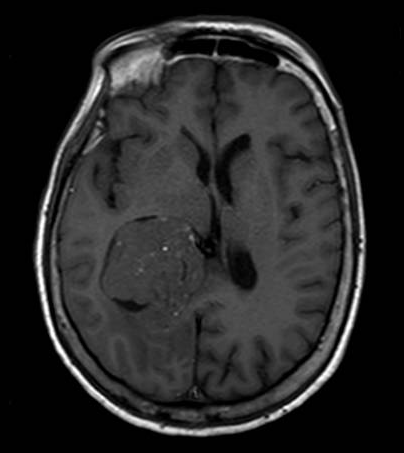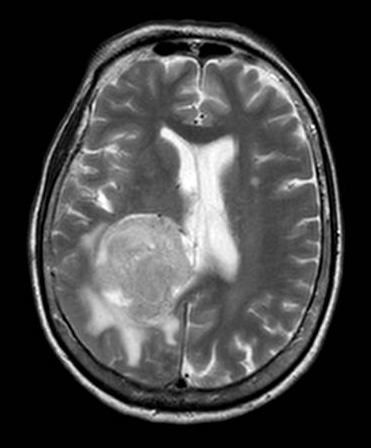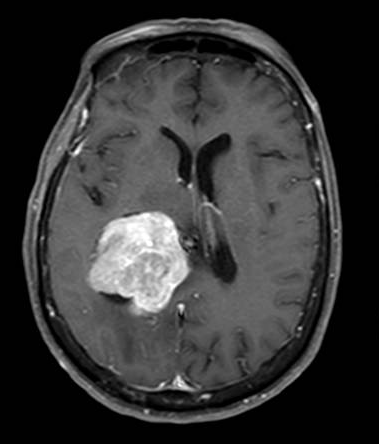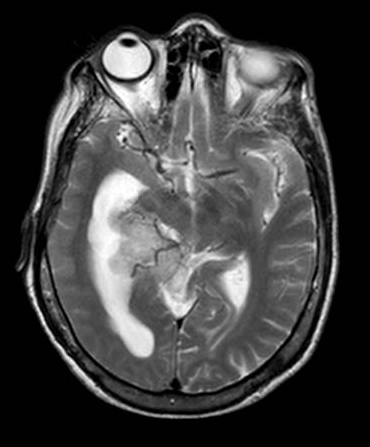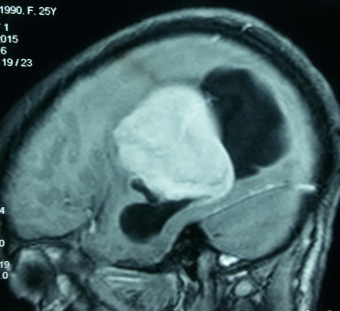[1]
Jungwirth G, Warta R, Beynon C, Sahm F, von Deimling A, Unterberg A, Herold-Mende C, Jungk C. Intraventricular meningiomas frequently harbor NF2 mutations but lack common genetic alterations in TRAF7, AKT1, SMO, KLF4, PIK3CA, and TERT. Acta neuropathologica communications. 2019 Aug 30:7(1):140. doi: 10.1186/s40478-019-0793-4. Epub 2019 Aug 30
[PubMed PMID: 31470906]
[2]
Connolly ID, Cole T, Veeravagu A, Popat R, Ratliff J, Li G. Craniotomy for Resection of Meningioma: An Age-Stratified Analysis of the MarketScan Longitudinal Database. World neurosurgery. 2015 Dec:84(6):1864-70. doi: 10.1016/j.wneu.2015.08.018. Epub 2015 Aug 28
[PubMed PMID: 26318633]
[3]
Portet S, Banor T, Bousquet J, Simonneau A, Flores M, Ingrand P, Milin S, Karayan-Tapon L, Bataille B. New Insights into Expression of Hormonal Receptors by Meningiomas. World neurosurgery. 2020 Aug:140():e87-e96. doi: 10.1016/j.wneu.2020.04.168. Epub 2020 May 1
[PubMed PMID: 32371078]
[4]
Gurcay AG, Bozkurt I, Senturk S, Kazanci A, Gurcan O, Turkoglu OF, Beskonakli E. Diagnosis, Treatment, and Management Strategy of Meningioma during Pregnancy. Asian journal of neurosurgery. 2018 Jan-Mar:13(1):86-89. doi: 10.4103/1793-5482.181115. Epub
[PubMed PMID: 29492130]
[5]
Braganza MZ, Kitahara CM, Berrington de González A, Inskip PD, Johnson KJ, Rajaraman P. Ionizing radiation and the risk of brain and central nervous system tumors: a systematic review. Neuro-oncology. 2012 Nov:14(11):1316-24. doi: 10.1093/neuonc/nos208. Epub 2012 Sep 5
[PubMed PMID: 22952197]
Level 1 (high-level) evidence
[6]
Shibuya M. Pathology and molecular genetics of meningioma: recent advances. Neurologia medico-chirurgica. 2015:55(1):14-27. doi: 10.2176/nmc.ra.2014-0233. Epub 2014 Dec 20
[PubMed PMID: 25744347]
Level 3 (low-level) evidence
[7]
Ostrom QT, Cioffi G, Gittleman H, Patil N, Waite K, Kruchko C, Barnholtz-Sloan JS. CBTRUS Statistical Report: Primary Brain and Other Central Nervous System Tumors Diagnosed in the United States in 2012-2016. Neuro-oncology. 2019 Nov 1:21(Suppl 5):v1-v100. doi: 10.1093/neuonc/noz150. Epub
[PubMed PMID: 31675094]
[8]
Pereira BJA, de Almeida AN, Paiva WS, de Aguiar PHP, Teixeira MJ, Marie SKN. Natural history of intraventricular meningiomas: systematic review. Neurosurgical review. 2020 Apr:43(2):513-523. doi: 10.1007/s10143-018-1019-0. Epub 2018 Aug 15
[PubMed PMID: 30112665]
Level 1 (high-level) evidence
[9]
Lapras C, Deruty R, Bret P. Tumors of the lateral ventricles. Advances and technical standards in neurosurgery. 1984:11():103-67
[PubMed PMID: 6536266]
Level 3 (low-level) evidence
[10]
Leśniewski K, Kunert P, Matyja E, Czernicki T, Wójtowicz K, Wojciechowski J, Marchel A. Trigone ventricular meningiomas - clinical characteristics, histopathology and results of surgical treatment. Neurologia i neurochirurgia polska. 2019:53(1):34-42. doi: 10.5603/PJNNS.a2019.0007. Epub 2019 Jan 10
[PubMed PMID: 30628049]
[12]
Fornari M, Savoiardo M, Morello G, Solero CL. Meningiomas of the lateral ventricles. Neuroradiological and surgical considerations in 18 cases. Journal of neurosurgery. 1981 Jan:54(1):64-74
[PubMed PMID: 7463122]
Level 3 (low-level) evidence
[13]
Criscuolo GR, Symon L. Intraventricular meningioma. A review of 10 cases of the National Hospital, Queen Square (1974-1985) with reference to the literature. Acta neurochirurgica. 1986:83(3-4):83-91
[PubMed PMID: 3492867]
Level 3 (low-level) evidence
[14]
Li Z, Li H, Jiao Y, Ma J, Wang S, Cao Y, Zhao J. Clinical features and long-term outcomes of pediatric intraventricular meningiomas: data from a single neurosurgical center. Neurosurgical review. 2018 Apr:41(2):525-530. doi: 10.1007/s10143-017-0884-2. Epub 2017 Aug 2
[PubMed PMID: 28766173]
[15]
Dash C, Pasricha R, Gurjar H, Singh PK, Sharma BS. Pediatric intraventricular meningioma: A series of six cases. Journal of pediatric neurosciences. 2016 Jul-Sep:11(3):193-196
[PubMed PMID: 27857785]
Level 3 (low-level) evidence
[16]
Bhatoe HS, Singh P, Dutta V. Intraventricular meningiomas: a clinicopathological study and review. Neurosurgical focus. 2006 Mar 15:20(3):E9
[PubMed PMID: 16599425]
[17]
Kepes JJ. Presidential address: the histopathology of meningiomas. A reflection of origins and expected behavior? Journal of neuropathology and experimental neurology. 1986 Mar:45(2):95-107
[PubMed PMID: 3005518]
[18]
Shuangshoti S, Netsky MG. Histogenesis of choroid plexus in man. The American journal of anatomy. 1966 Jan:118(1):283-316
[PubMed PMID: 5915034]
[19]
Wannamaker GT. Intraventricular meningioma of the brain. Journal of the South Carolina Medical Association (1975). 1974 Aug:70(8):262-3
[PubMed PMID: 4546839]
[20]
Gruss P, Engelhardt F, Kolmann HL, Völpel M. Ventricular meningiomas--report of 4 cases. Neurosurgical review. 1987:10(4):295-8
[PubMed PMID: 3506143]
Level 3 (low-level) evidence
[21]
Mani RL, Hedgcock MW, Mass SI, Gilmor RL, Enzmann DR, Eisenberg RL. Radiographic diagnosis of meningioma of the lateral ventricle. Review of 22 cases. Journal of neurosurgery. 1978 Aug:49(2):249-55
[PubMed PMID: 671077]
Level 3 (low-level) evidence
[22]
Lozier AP, Bruce JN. Meningiomas of the velum interpositum: surgical considerations. Neurosurgical focus. 2003 Jul 15:15(1):E11
[PubMed PMID: 15355013]
[23]
Behari S, Das KK, Kumar A, Mehrotra A, Srivastava AK, Sahu RN, Jaiswal AK. Large/giant meningiomas of posterior third ventricular region: falcotentorial or velum interpositum? Neurology India. 2014 May-Jun:62(3):290-5. doi: 10.4103/0028-3886.136934. Epub
[PubMed PMID: 25033852]
[24]
Champagne PO, Bojanowski MW. Meningioma of the superior leaflet of the velum interpositum: A case report. Surgical neurology international. 2015:6(Suppl 3):S132-5. doi: 10.4103/2152-7806.155703. Epub 2015 Apr 22
[PubMed PMID: 25949856]
Level 3 (low-level) evidence
[25]
Eom KS, Kim DW, Kim TY. Diffuse craniospinal metastases of intraventricular rhabdoid papillary meningioma with glial fibrillary acidic protein expression: a case report. Clinical neurology and neurosurgery. 2009 Sep:111(7):619-23. doi: 10.1016/j.clineuro.2009.05.002. Epub 2009 May 30
[PubMed PMID: 19482417]
Level 3 (low-level) evidence
[26]
Cheng Z, Chao Q, Zhang H, Wang DW, Shu HS. Intraventricular cystic papillary meningioma: A case report and literature review. Medicine. 2020 Jul 31:99(31):e21514. doi: 10.1097/MD.0000000000021514. Epub
[PubMed PMID: 32756190]
Level 3 (low-level) evidence
[27]
Tao CY, Wang JJ, Li H, You C. Malignant intraventricular meningioma with craniospinal dissemination and concurrent pulmonary metastasis. World journal of surgical oncology. 2014 Jul 30:12():238. doi: 10.1186/1477-7819-12-238. Epub 2014 Jul 30
[PubMed PMID: 25073808]
[28]
Louis DN, Perry A, Reifenberger G, von Deimling A, Figarella-Branger D, Cavenee WK, Ohgaki H, Wiestler OD, Kleihues P, Ellison DW. The 2016 World Health Organization Classification of Tumors of the Central Nervous System: a summary. Acta neuropathologica. 2016 Jun:131(6):803-20. doi: 10.1007/s00401-016-1545-1. Epub 2016 May 9
[PubMed PMID: 27157931]
[29]
Backer-Grøndahl T, Moen BH, Torp SH. The histopathological spectrum of human meningiomas. International journal of clinical and experimental pathology. 2012:5(3):231-42
[PubMed PMID: 22558478]
[30]
Staempfli P, Reischauer C, Jaermann T, Valavanis A, Kollias S, Boesiger P. Combining fMRI and DTI: a framework for exploring the limits of fMRI-guided DTI fiber tracking and for verifying DTI-based fiber tractography results. NeuroImage. 2008 Jan 1:39(1):119-26
[PubMed PMID: 17931889]
[31]
Nimsky C, Ganslandt O, Hastreiter P, Wang R, Benner T, Sorensen AG, Fahlbusch R. Preoperative and intraoperative diffusion tensor imaging-based fiber tracking in glioma surgery. Neurosurgery. 2005:56(1):130-7; discussion 138
[PubMed PMID: 15617595]
[32]
Wei CW, Guo G, Mikulis DJ. Tumor effects on cerebral white matter as characterized by diffusion tensor tractography. The Canadian journal of neurological sciences. Le journal canadien des sciences neurologiques. 2007 Feb:34(1):62-8
[PubMed PMID: 17352349]
[33]
Pollock BE, Stafford SL, Utter A, Giannini C, Schreiner SA. Stereotactic radiosurgery provides equivalent tumor control to Simpson Grade 1 resection for patients with small- to medium-size meningiomas. International journal of radiation oncology, biology, physics. 2003 Mar 15:55(4):1000-5
[PubMed PMID: 12605979]
[34]
Kim IY, Kondziolka D, Niranjan A, Flickinger JC, Lunsford LD. Gamma knife radiosurgery for intraventricular meningiomas. Acta neurochirurgica. 2009 May:151(5):447-52; discussion 452. doi: 10.1007/s00701-009-0273-x. Epub 2009 Apr 1
[PubMed PMID: 19337685]
[35]
Nayar VV, DeMonte F, Yoshor D, Blacklock JB, Sawaya R. Surgical approaches to meningiomas of the lateral ventricles. Clinical neurology and neurosurgery. 2010 Jun:112(5):400-5. doi: 10.1016/j.clineuro.2010.02.005. Epub 2010 Mar 1
[PubMed PMID: 20197209]
[36]
Nanda A, Bir SC, Maiti T, Konar S. Intraventricular Meningioma: Technical Nuances in Surgical Management. World neurosurgery. 2016 Apr:88():526-537. doi: 10.1016/j.wneu.2015.10.071. Epub 2015 Nov 5
[PubMed PMID: 26548837]
[37]
d'Avella D,Rossetto M,Denaro L,Sturiale CL, Lateral ventricle's choroid plexus tumors surgery in children: how I do it. Acta neurochirurgica. 2014 Jan;
[PubMed PMID: 24170297]
[38]
D'Angelo VA, Galarza M, Catapano D, Monte V, Bisceglia M, Carosi I. Lateral ventricle tumors: surgical strategies according to tumor origin and development--a series of 72 cases. Neurosurgery. 2005 Jan:56(1 Suppl):36-45; discussion 36-45
[PubMed PMID: 15799791]
Level 3 (low-level) evidence
[39]
Kempe LG, Blaylock R. Lateral-trigonal intraventricular tumors. A new operative approach. Acta neurochirurgica. 1976:35(4):233-42
[PubMed PMID: 998353]
[40]
D'Angelo VA, Galarza M, Catapano D, Monte V, Bisceglia M, Carosi I. Lateral ventricle tumors: surgical strategies according to tumor origin and development--a series of 72 cases. Neurosurgery. 2008 Jun:62(6 Suppl 3):1066-75. doi: 10.1227/01.neu.0000333772.35822.37. Epub
[PubMed PMID: 18695527]
Level 3 (low-level) evidence

